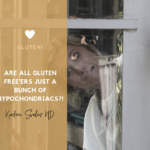Last week’s post talking about gluten intolerance, “Are all Gluten-Free’ers just a bunch of Hypochondriacs?!” was pretty popular. So I’m turning it into a 4 part series.
This week I am going to take you through the signs and symptoms of a gluten intolerance.
Next week we’ll talk about how to actually transition into a gluten free diet.
Then the week after that we’ll go though how you can heal yourself from Gluten Intolerance (I’m never going to say that gluten is good for anybody. But I get it. Pizza is tasty (Almond croissants are my Kryptonite).
First up, what is gluten?
Gluten is a family of proteins found in grains like wheat, rye, spelt and barley.
If you care to know, Gluten is found in the endosperm (tissue produced inside the seeds of most of the flowering plants following fertilization).
This little tidbit explains why you find gluten in wheat, but not in wheatgrass. So shooter up!
There’s a couple of grains that shouldn’t contain gluten, but often do.
These include foods like oats, rice and quinoa.
And it’s during processing that they get cross-contaminated with foods that do contain gluten.
So if you’re buying these, make sure it states on the packaging that they are gluten free (there’ll usually be a disclaimer near the nutrition info in cases of possible cross-contamination).
When it comes to being told what’s in our food, we often don’t get the full story.
Gluten can be snuck into gluten free foods by the way of “natural” additives. I’ve personally seen packaging claiming a gluten free product have additives made from gluten. Sneaky. And mean.
Next, what’s the difference between Gluten Intolerance & Celiac Disease
Having a Gluten Intolerance means that your body is more sensitive gluten.
Having Celiac Disease means that you are allergic to gluten. It sends the immune system crazy. And absolutely wrecks the gut. It can take up to 6 MONTHS for a Celiac’s gut to get back to normal after just one ingestion. Even from using the same bread board. Really.
So if you know someone with Celiacs, please don’t ever say “just a little won’t hurt”. It will.
This is a little video I did on my Facebook page a while back explaining the difference between a food intolerance, and a food allergy.
Testing for Gluten Intolerance & Celiacs
So there’s not really a test as such for Gluten Intolerance, I don’t really give much credit to Food Intolerance tests (and I wrote a blog post on why here).
If you want to test your tolerance, or not, to gluten I recommend taking gluten completely out of your diet for a minimum of one week. Track how you feel before and after in terms of energy, brain fog, joint pain etc and see how different you feel.
If you find you have more energy, have less anxiety/depression, and/or any skin issues improve I’d say you’re intolerant to gluten and would benefit from removing it from your diet.
There is testing available to see if you have Celiacs Disease, three main ones.
Two of them are pretty horrific. The other is really simple.
The “Gold Standard” has always been considered to be the Small Bowel Biopsy, this is where they go in with a camera to see how much damage there is to the small intestine.
The second is a blood test looking for Transglutaminase Antibodies (tTG).
Buttttt, to get an accurate result for both these tests, you have to have been consuming the equivalent of at least 4 slices of gluten containing bread per day for 2 to 6 weeks. Ouch. That’s going to hurt anyone’s guts. Intolerant to gluten or not.
And a lot of my clients report never being told this prior to testing.
I want to cry at the amount of people out there that have been told by their doctor that they do not have Celiacs Disease when there is good chance they might.
So then the third way, the one I recommend starting with is a nice and gentle gene test.
The two genes that you want to test for are HLA-DQ2 and HLA-DQ8. Easily done through a blood test with your GP.
If you do not have these gene variations you can never get Celiacs.
If you do have these genes there’s a 1 in 30 chance that you may develop it (dietary and lifestyle choices will affect). So if you come back positive for these genes, then you might consider the transglutaminase test (in some countries that absolute diagnosis is needed for receiving some medical and tax benefits).
This study goes a lot more in depth about the Diagnosis of Celiac Disease.
Common Gluten Intolerance Symptoms
The damage may start in the gut, but symptoms of gluten intolerance go far beyond and affect the whole body.
This study published in the World Journal of Clinical Cases finds that gluten related disorders affect not just the digestive system, but also the immune system (allergies), the nervous system (depression), and integumentary system (skin conditions).
I say all the systems.
Uncontrolled inflammation is is the root of almost all diseases. Especially cancer.
So, because gluten causes inflammation in the body, as well as auto-immune conditions, it’s connected with so many of the diseases we know today.
What you might see or feel if you’re gluten intolerant:
-
Digestive System:
Irritable Bowel Syndrome (IBS)
Small Intestinal Bacterial Overgrowth (SIBO)
Unexplained Weight Loss or Weight Gain
-
Nervous System:
Anxiety
Depression
Brain Fog
Poor memory
ADHD
Headaches and/or Migraines
Numbness & Tingling in arms and legs
-
Adrenal System:
Low energy
Chronic Fatigue
Trouble sleeping
-
Musculo-skeletal System:
Joint pain
Muscle pain
Arthritis
-
Reproductive & Endocrine System:
Infertility
Low sex drive
Irregular menstrual cycle
-
Integumentary System (skin)
Acne
Dermatitis
Psoriasis
Eczema
Rosacea
Skin Rashes
-
Cardiovascular System:
Heart Palpitations
Irregular Heartbeat
Coronary Artery Disease
-
Immune System
Autoimmune Diseases (ie Hashimotos, Rheumatoid Arthritis, Multiple Sclerosis…)
Frequent colds and flu
Hayfever
Darn gluten!
And in case you’re wondering why there is such a rise in people having issues with gluten, one of the reasons is because our food is very different to what it was even just one generation ago.
Wheat used to be 10% gluten. Now it’s about 50% gluten.
Better for the bakers as it makes the dough more pliable.
Worse for us as it makes us sick.
And then, another thing to consider if its wheat you’re reacting to: the harvesting practices.
In the States (with non-organic wheat) they spray the whole damn crop with ROUND UP(!) before harvesting as it gives them a bigger yield.
Round up is a pesticide that has its origins from Agent Orange (you know that stuff they used in the Vietnam War to make the trees lose their leaves so they could see the Viet Cong hiding in the jungle).
Can’t tolerate bread back home but do just fine with the baguettes in France? I hear this all the time.
What to do if you think you might be gluten intolerant?
1. Consider trying an elimination diet
(there’s multiple kinds of elimination diets, have a complimentary chat with me and I can help you determine which one would be most appropriate)
But for gluten I recommend taking it out for at least 6 weeks. Assessing yourself before and after.
2. Trial a gluten free diet
(more on this in next week’s post)
But for starters, try replacing your regular bread with these Cauliflower Bagels, or these yummy Swedish Breakfast Buns.
Want something more crunchy? Got you covered with these Cheesy Almond Rosemary Crackers.
3. Consider having tests done
Because then at least you know.
I’d start with those 2 gene tests (HLA DQ-2 & HLA-DQ8).
Then if those come back positive you can consider the Transglutaminase Antibodies (tTG) one. Just remember you have to do that “gluten challenge” for six weeks prior otherwise you won’t get an accurate result.





